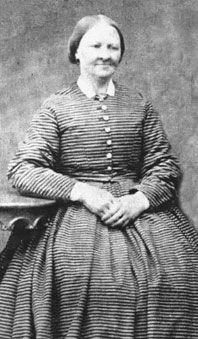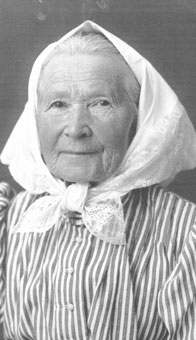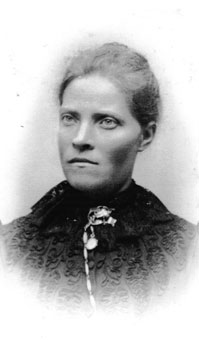Gränna town
c
PARISHES
Gränna
Visingsö
Ölmstad
Skärstad
Huskvarna
Järsnäs
Vireda
Lemnhult |
|
Gränna town
|
|
| |
c
 |
c
Amalia Eriksson 1824 - 1923
Amalia Eriksson was born in 1824 i Jönköping. At an age of thirtyone she moved with her family to Gränna and two years later she married Anders Eriksson who was a tailor. Unfortunately he died already in 1858, just one week after their daughter was born.
At this time women had very few possibilities to run a business, but social reasons could in some cases give them the right to do it. After the death of Amalia Eriksson´s husband, she therefore was given permission to start a bakery. In time she became the first one to manufacture peppermint rocks. Business went well and soon Amalia Eriksson was not the only manufacturer in town.
After Amalia Eriksson´s death, the company was taken over by her daughter Ida, who continued all her life, until 1945.
c
Contact: Writers Group Salve Venia; Leader: Rakel Fast, Phone No: +46390-12163
|
| |
|
|
|
| |
c  |
c
Augusta Jakobsdotter 1836-1927
Augusta Jakobsdotter came as a twenty year old to Gränna from Visingsö. She began working as a homemaid at the Frank family. When Carolina Bark became a widow in 1856, Augusta took her place. In the household there was even the eight year old daughter Valborg, who later on became famous for her private school.
Valborg inherited the country estate and accordingly even the loyal maid Augusta, who became an indispensable help for her. In time, they even evaluated a warm friendship and Augusta was honored by Hushållningssällskapet with a gift. Augusta stayed with Valborg until her death in 1927 and now they rest in the same grave at the Gränna cemetary.
Contact: Writers Group Salve Venia; Leader: Rakel Fast, Phone No: +46390-12163
|
|
|
|
|
|
| |
c
c
|
Emma Katarina Andersdotter
1858 - 1941
In 1885 Emma - even called Emma i Buren, after her cottage - moved together with her parents to Gränna. She was employed by J E Landström who owned a market garden, in which she stayed for fifty years. She worked from 6.00 am to 8.00 pm at a salary of 50 öre a day. She also began selling vegetables on behalf of Landstrom.
In the summer Emma went there by boat six days a week and in the winter twice a week. In order to avoid being charged for the transport she hung the vegetables around her neck. She sold the vegetables in Jönköping harbor and later on at the Järnvägstorget (the market place). The last years she was at the Jönköping market place.
Emma had two children but was never married.
Contact: Writers Group Salve Venia; Leader: Rakel Fast, Phone No: +46390-12163
|
|
| |
|
|
|
c
|
Calla Sundbäck 1861-1930.
At the end of the 19th century the photograf profession became very popular and women were allowed in it. This profession was a safe and economically stabile one.
Toward the end of the 1880´s Calla Sundbäck came to Gränna. In 1910 she opened her studio on Brahegatan 39 (currently Kalles tobak/tobacco store), working together with her sister until 1930. On the bike, with a bulky camera, she went around the countryside, making portraits of both known and unknown people.
Calla had great talent and became very successful. Her photographs have a very high quality and is an invaluable asset. She received several prestigious awards and became nationally known. In 1921 she even was appointed royal photographer to the king.
Calla was true to his profession for life. She was an accomplished professional woman and a true philanthropist.
Contact: Writers Group Salve Venia; Leader: Rakel Fast, Phone No: +46390-12163
|
|
| |
|
c
|
cc
Valborg Jakobina Frank 1847-1929
Valborg originated from Germany but the family moved to Gränna in 1855 where she was put to the Strussenfeldtska school. She also spent some years in Stockholm, where she was put to another school.
Back in Gränna, she was employed as a governess. Later she was employed a teacher at Hvarf rectory of Reverend Blomgren, where she taught children of the family and had a very fine grade.
In 1874 she became a student at Kungliga Telegrafverket (the Royal Telegraph Administration) in Nora. She went through the tests in English, German and French as she passed with flying colors, but failed in the telegraph test and therefore had no degree.
Instead Valborg opened the first private school for girls in her parents home in Gränna in 1875. Students paid six kronor a month depending on what subjects they chose. From 1893 even boys got access to this school.Valborg had great interest in literature and provided a comprehensive library after her.
Contact: Writers Group Salve Venia; Leader: Rakel Fast, Phone No: +46390-12163
|
| |
|
Inget foto |
c
Ellen Karolina Johansson 1887-1964
Ellen in Röttle early became a widow with three small children. She was then forced to take several different jobs and it was long hours with many different tasks such as laundry, hay-raking, watching over the sick and wrapping corpses in the village. She was considered to be a clairvoyant and was also knowledgeable in medicine.
Later she was asked to take foster children, which pleased her much, as she could be home instead. During thirty-five years Ellen had care of twenty-one children, three of her own and eighteen foster children. Ellen loved the children and was proud of them. She was strict but fair with them and felt that schoolwork was the most important issue in their life. Ellen's efforts for the children is difficult to estimate, but all did well in life and was certainly very happy and grateful that Mother Ellen in Röttle had taken such good care of them.
Contact: Writers Group Salve Venia; Leader: Rakel Fast, Phone No: +46390-12163 |
| |
|
Inget foto |
c
Lotta Johannisson 1850-1904
The state of the Visingsö residents has always been troublesome when it comes to supplies that they could not produce themselves. So it was natural that those who were subject to Jönköping helped others to get home goods.
For approximately twenty years Masa-Lotta, a rural original from Visingsö, served as envoy to the island-dwellers. She crossed the steamer Örn (Eagle). In the winter, she took the boat to Gränna and walked the long road to Jönköping. It is said that she could not read but she could still meet her mission because of her unusually good memory. She was tall and physically strong. It is said that she was carrying bags in both front and back of hands and arms, since there was an extra cost to put the baskets on the deck surface. Masa-Lotta was considered honest and compassionate. Unfortunately already in 1904, she died, however, after having suffered a severe pneumonia.
Contact: Writers Group Salve Venia; Leader: Rakel Fast, Phone No: +46390-12163
|
| |
|
c
|
c
Nanny Linnéa Fredriksson 1884-1965
At an age of twenty-six Nanny went on a mission for Helgelseförbundet (the Holiness Association). Nanny took her vocation seriously and came to China in 1911 at the time of fall of the Tsar. Here she worked for a long time apart from a period home with a commitment to Arvidsgården in Uppgränna. Nanny worked in Northern China and was a diligent missionary.
Eventually she was arrested, however, and accused of spying against both the Soviet Union, China's communists and the government. Finally Nanny sentenced to five months in prison. She was released, however, three days before Christmas 1942 and could continue her work until the communist seizure of power by 1949-50. After some years home in Gränna, Nanny was she ready to mission again, this time to Japan, then Taiwan. Nanny became a legend in her work as a missionary and revivalist.
Contact: Writers Group Salve Venia; Leader: Rakel Fast, Phone No: +46390-12163
|
| |
|
|
cc
Märta Pärsson 1887-1972
Martha grew up in a cottage in Aranäs mansion where her father worked. The home was warm, religious and very musical. They lived nine people in one room and kitchen. Martha started working already as a 13-year-old. Twice a day she ran to the mansion to feed Aranäs about 600 chickens. Later she worked as a maid inside. Next door lived Gustav Persson, who became her companion.
Marta got both housing and shoemaking for them in Gränna. For more than thirty years she worked as a school cleaner. For this she was honored with the Gränna city medal. In 1943 she was elected as the first Social Democrat woman into the Gränna town council. Having strong faith in God, she got her spiritual home in the Salvation Army. She was known for her ability to play the violin and singing simultaneously. For posterity, she is remembered as a "versatile woman and a happy salvationist".
Contact: Writers Group Salve Venia; Leader: Rakel Fast, Phone No: 0390-12163
|
| |
|
c
|
c
Annie Falk Persson, Ester E Falk
The two sisters Annie and Esther's life started in Gothenburg, where they were well-established real estate agents and part owners of a small business. In the 20's they spent their summers in Örserum in order to get some rest and recreation. They came to love the place and settled there. How and when the plans to build a sanatorium in Örserum developped, it is not known. Possibly they wanted to leave something lasting behind. Smålandsgården became ready for inauguration, after a lot of commitment, both work and money, in1933. The intention was that the farm would be used for the treatment of rheumatic disease among others. When Annie died, Esther wrote a new will in which she donated allkvarlåtenskap to Frälsningsarmén (the Salvation Army).
Contact: Writers Group Salve Venia; Leader: Rakel Fast, Phone No: +46390-12163 |
| |
|
|
|

